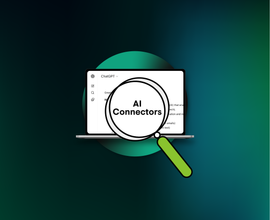Brand Authority in AI: A CMO’s Guide to AI Search Signals
Building brand authority in the age of AI calls for a fundamental shift from capturing clicks to earning a spot on a buyer's mental shortlist. With 50% of B2B buyers now using AI for primary research, the game is often won or lost before they ever visit your website. The goal is no longer just driving traffic; it’s about becoming one of the few "known vendors" buyers consider before a formal search begins.
Learn how marketing leaders are moving beyond traditional SEO to a disciplined strategy of owning specific topics, mastering content adjacencies, and relentlessly repeating their message to ensure they are the authoritative source that AEO / GEO and their audience trust.
User behaviors are shifting rapidly, and brands need to adapt. The challenge isn't just meeting audiences where they are—it's changing how you build authority through content.
Research analyzing thousands of RFPs reveals a critical insight: on average, an RFP contains four vendors, and buyers already know three of those vendors before they start their formal search. The old search signals are changing, and tactics that used to drive engagement and stronger rankingsRankings
Rankings in SEO refers to a website’s position in the search engine results page.
Learn more don't move the needle like they used to. If you're not one of those three known vendors in your buyer's mind, you're fighting for scraps.
According to Jon Ewing, Head of Marketing at Dun & Bradstreet, there's a four-step playbook for becoming one of those known vendors:
- Align your organization on topic ownership: Your aim is to build a connection in the minds of your addressable market between your brand and the topic or category that you want to be known for. The hardest part isn't creating content—it's getting the entire business to agree on which specific topics you want to own.
- Build a content moat around your topics: Analyze where your authority stands today, then create consistent, high-quality content that establishes you as the definitive source.
- Target adjacent topics strategically: Zero-click searches mean buyers won't browse your site casually. Create content on related topics so your brand appears across broader conversations—you need to cast a broad net.
- Measure authority and repeat your message: Track how your topic authority grows over time and weave your core brand message into every piece of content you create.

How do you get on your customers’ shortlist?
With all this change, what's the actual goal of brand marketing? We can think of marketing as having two core goals:
- First, there’s demand capture: going after people who are actively investigating your product category right now.
- Then there’s future demand generation, which is all about playing the long game. It’s about making sure future customers think of you when they eventually need what you provide. This is the goal of brand marketing.
Research from Gartner and Forrester analyzing thousands of requests for proposal (RFPs) reveals how this plays out in practice. When companies formally solicit vendor bids, they typically list four potential partners. But here's the critical insight: buyers already knew three of those four vendors before they ever started the evaluation process. By the time your brand appears on an RFP, the shortlist has already been set.
The job of brand marketing is to make sure that my business is one of those three. If I fail at brand marketing, then my business, my sales team are scrabbling around for that fourth position, and you don't want to be doing that. That's the also-rans.
This idea isn’t specifically tied to RFPs—they just provide measurable data. This same principle applies to almost every significant B2B purchase. Before anyone searches "best CRM software" or "top data providers," they already have a few names floating in their head. The game is won or lost long before they hit enter.
Why is it important to show up in AI search?
For years, the brand-building playbook was pretty straightforward. Craft a clear message and repeat it everywhere—on your website, in programmatic ads, in traditional media, at industry events, through sports sponsorships, and through your social channels. The goal was to get people to your site, where you could control the narrative and guide them through your content.
But thanks to AEO / GEO, that journey is getting more difficult.
The rise of zero-click searches and AI-powered answers means people are getting what they need without ever visiting your website. This has a ripple effect: Fewer website visits mean fewer ad impressions and less control over how your brand story gets told. You lose your chance to show them your next piece of content and reinforce your core messaging. You no longer have direct control over the narrative.
In the last year, the number of B2B buyers using generative AI as their primary source for research has nearly doubled, jumping to 50% .
If half your potential customers are starting their journey in an LLM, what happens when your brand doesn't show up?
Those of you who've been around a while will remember the old SEO joke about [how] the best place to hide a body is on the second page of Google search results. I think now you could update that punchline to be the best place to hide a body is on a website that isn't indexed or isn't summarized by LLMs. You're just going to vanish. You're going to disappear.

The playbook for building brand authority in AI
How do you ensure you’re being referenced on LLMs and avoid vanishing?
Here's the four-step approach to building brand authority when LLMs are the new mode of search.
Step 1: Start with strategy
Before you write a single blog post, get into the nitty-gritty of your own brand. The first step isn’t about keywords; it's about getting the entire business to agree on what you want to be known for. Nail down the specific topics and categories you want to completely own in the minds of your customers.
This sounds simple, but it’s often the biggest hurdle, especially for companies with diverse offerings.
What are the topics we want to own? We suffer from wanting to be everything to everyone, and I think one of the things about AI is it's kind of a lens by which we're having to decide where we really want to play.
Step 2: Build your content moat
Once you determine what you want to be known for, start building your content moat. Analyze where your website’s authority currently stands on your target topics and then create a consistent stream of high-quality content to expand your authority and dominate the conversation.
Step 3: Target topic adjacencies
In the past, you could rely on visitors clicking around your site to discover related content. AI summaries and zero-click searches largely remove that possibility. That’s where topic adjacencies come in.
Topic adjacencies refer to creating content not just on your core offering, but on all the related concepts your audience might be exploring. If your core topic is "data management," your adjacencies might be "database technology," "how to cleanse your data," or "the importance of a primary key." This strategy casts a wider net with your content, ensuring your brand shows up in related conversations within LLMs to further boost your authority on your target topic.
Step 4: Measure and repeat
Like most website and brand optimizations, this isn’t a one-and-done project. It requires constant measurement to see how your authority on these topics is growing, especially against your competitors.
And above all, repeat your core message relentlessly. Weave that simple, powerful brand promise into every piece of content you create for your core topics and adjacent topics. That constant repetition that builds the mental connection you need to become one of the “known three.”
Your brand is what AI says it is
In the end, the core job of a brand marketer hasn't really changed. It’s still about earning a spot in your customer’s mind before they even realize they need you. What has changed is where you meet your audience. The new front line is AI visibility, and winning requires a more deliberate and focused strategy than ever before.
It’s no longer enough to just produce good content and hope people find it. You have to strategically build and amplify your authority where your audience is actually looking.
As Jon Ewing’s playbook shows, it comes down to choosing your battles, creating content that dominates those specific topics, and repeating your core message until it’s impossible to ignore.
I often feel like being a marketer is a bit like being a parent, where you just have to tell your kids again and again and again to brush their teeth. It's the same thing. We need to kind of push that message until it becomes so subliminal in the mind of our buyer that they don't even know why they know our name, but when they think about the category, they think about us
In the age of AEO / GEO, that relentless consistency is your brand's key to survival.
Audience Q&A
Q: How do you get organizational buy-in for AI tools?
Making AI tools work across a marketing organization requires eliminating silos. SEO can't be one team's responsibility—it needs to belong to everyone. When teams understand these tools as essential for efficiency rather than optional nice-to-haves, adoption becomes easier. The key is being direct: AI tools represent the future of content marketingContent Marketing
Content marketing is a marketing discipline with the goal of increasing awareness and scope for products and brands in the desired target group with content published on the web and offline.
Learn more, and learning them isn't optional for staying relevant.
Q: What types of content perform best in AI search?
Early results show Q&A content, FAQ pages, and comparison content perform particularly well in AI search. One interesting pattern is that competitor pages comparing themselves to your brand often rank higher than your own product pages, which means competitors currently own those conversations. Creating your own comparison content helps you reclaim that narrative.
Q: How do you balance creating content for bots versus humans?
Balancing content for AI crawlers and human visitors requires strategic thinking. One approach is surfacing different content depending on the user agent—more detailed, granular information for bots, while maintaining cleaner navigation for human visitors. The challenge is ensuring your site map lists everything for bots without overwhelming people.
In summary
Brand marketing fundamentals haven't changed—you still need to earn a spot in your buyer's mind before they start searching. What has changed is where that battle happens. With half of B2B buyers using AI for primary research, visibility in LLMs isn't optional anymore.
The approach is straightforward: align your organization on which topics you'll own, build consistent content around those topics, expand into adjacent conversations, and measure your progress.
Most importantly, repeat your core message until it becomes impossible to ignore. The brands that succeed will become the trusted sources that AI and audiences cite.
Jon Ewing shared these insights and more during his C3 2025 session, Marketing Leader’s Guide to AI Search Signals—watch the full recording below.
This article is based on insights shared at C3—New York’s premiere AEO / GEO conference—brought to you by Conductor, and has been adapted for clarity and depth.

![Jon Ewing, Head of Marketing, [object Object]](https://cdn.sanity.io/images/tkl0o0xu/production/6162baa2fbca4a2b41e979948a95c5f9cfe4f7e4-1859x2048.jpg?fit=min&w=100&h=100&dpr=1&q=95)






